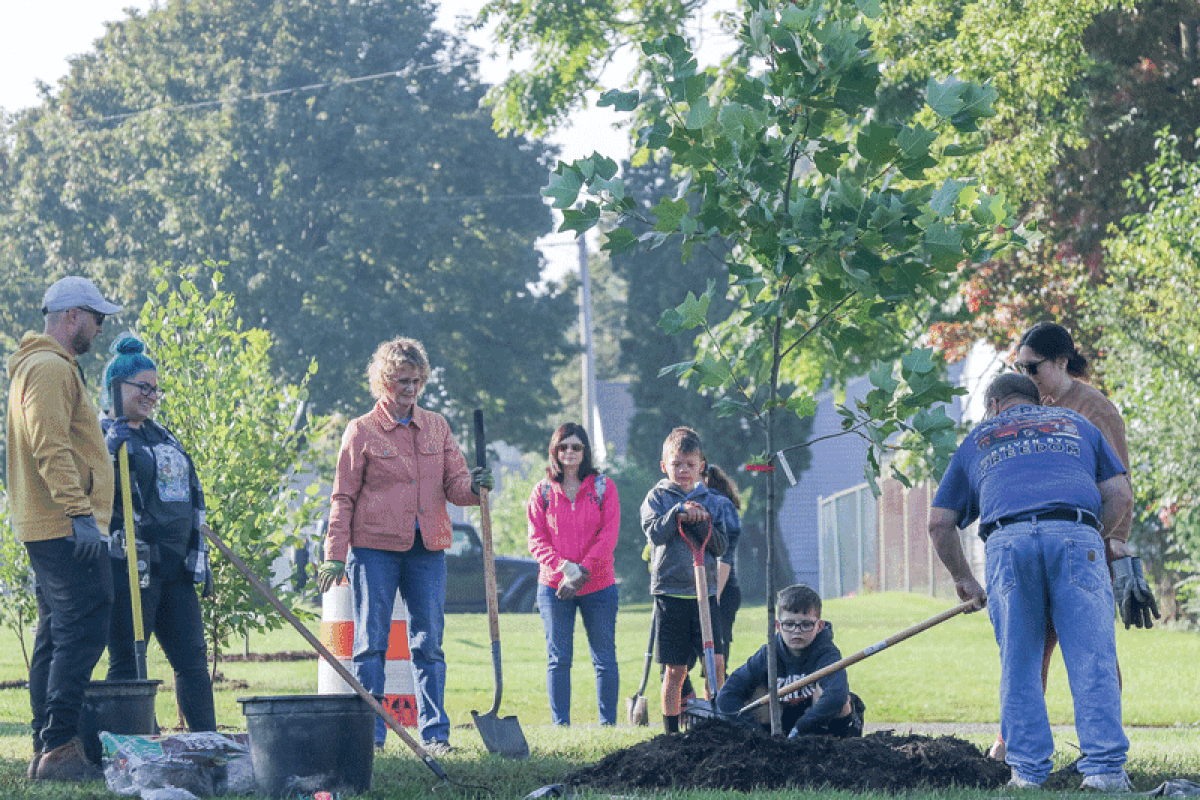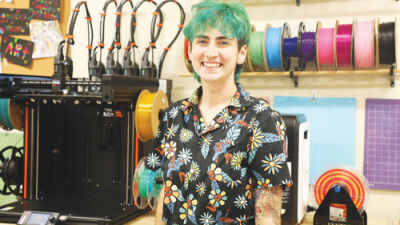HAZEL PARK — A group of Hazel Park homeowners are concerned about the way the city of Hazel Park trims and takes down trees, saying it’s decimating the tree canopy and hurting home values.
City officials, meanwhile, said the affected trees are potential hazards that could damage property or injure people, pointing to a recent incident where a local woman was stabbed by a fallen tree branch, and noting also that the city continually plants new trees to replace those that are lost.
“This is not a game,” said Ed Klobucher, the city manager and a lifelong resident of Hazel Park. “Sometimes, some trees are dangerous, and the best thing is to take them down.”
Residents express concerns
In a series of email interviews, several residents shared their perspectives.
“Main issue coming through is a complete lack of accountability and transparency, a lack of standard criteria, and zero resident input,” said resident Meghan Cleary. “It would be extremely easy for Hazel Park to post a simple Google spreadsheet online with a list of trees slated to be reviewed, their status and criteria for trimming/cutting, and date for the replacement tree planting.”
She is especially concerned about the trees cut down along Otis Avenue, a key greenbelt in Hazel Park that leads straight into a park and is frequented by children. She feels that many residents would gladly pay extra to install sidewalks that go around trees in cases where trees are in the way.
“In a city as green-starved as Hazel Park, it seems odd these strategies weren’t explored and deployed before ruining not only a key source of shade (and) CO2 removal, and not to mention property values,” Cleary said. “A city like ours really needs every source of beautification and natural green space we can get.”
Kimberly Bracken is a resident on East Woodruff Avenue.
“There were several trees butchered on my street. They were beautiful and healthy. It was one reason I bought this house. … They provided shade, and gorgeous color in the fall. We were given no warning. I woke to the terrible sound of saws and chippers. I asked the men why, and they had no good reason. It was just a job,” Bracken said. “It was sad, and several of my neighbors were upset. (The trees) provided oxygen and habitat.”
Some trees were replanted, but “I won’t be here to see them in their glory,” she said. “They say it was because sidewalks were being replaced. It seemed more like a money grab. They replaced perfectly good slabs and did a sloppy job. Some did need it, but I think much was unnecessary. … I’ve lived in Hazel Park since childhood, and it’s hard to see these barren streets.”
Kayla Thrushman also lives on East Woodruff Avenue. She said that when she moved there eight years ago, there were at least a dozen trees on the block. Now there are less than half of that.
“I have seen (the canopy) dwindle rapidly in the past two years. I am an avid runner and take neighborhood jogs with my dog weekly, and have seen the trees rapidly decline,” Thrushman said. “Although I was sent documentation about the sidewalk project taking place, I did not feel that the trees on my block were destroying the sidewalks or properties near them enough to cut them down. … The trees on our block appeared to be healthy, and not diseased as those who were cutting them down claimed.”
Rachel West lives in the Courts, where each court is named after a different type of tree.
“I live in Maple Court, which lost about 60% of its tree canopy in the span of two weeks,” West said. “The city did notify us we’d lose the two trees in front of our house, but we were not given a reason why. We were offered an opportunity to attend a town hall, which I declined. I figured I’d just drawn the short stick in needing to lose my property’s trees.
“My major concern is around the lack of communication about the sheer volume of trees my neighborhood would lose,” she said. “I can cope with losing two in front of my house, but I’m also affected by the loss of other trees in the neighborhood, as are all residents on my block and anyone who passes through.”
West has also not received an estimate about when the stumps will be removed, “which is a beautification issue that affects my property value,” she said. “I’m nervous Google Maps will update to show ugly stumps instead of stunning trees. Further, we’ve not been told if or when new trees will be planted, what variety they’ll be, or how old they’ll be, which is also concerning. This is my starter home, and I fear this issue could affect my ability to sell.”
The city’s response
Klobucher emphasized that nobody at City Hall wants to cut down trees. Many members of the city’s administration are residents of the city, including himself and Department of Public Works Superintendent Tom Jones as well as the City Council members.
“When I was a kid, I could identify everyone’s home by the shape of their tree. It’s sad to see a tree go when a neighborhood has looked that way for decades. It can be shocking to see it removed. But at the same time, it’s a tragedy when a tree falls on a house or another human being. So we have to make sure we’re protecting everybody,” Klobucher said. “Imagine if a kid was lying in their bed at night when the wind came through and knocked a branch down on them.”
He points to an incident in July where a windstorm knocked a massive tree branch onto the Elza Avenue home of Melissa and Micah Albers. The branch slid off the roof and stabbed Melissa, who was then rescued by Hazel Park paramedics. Klobucher said the incident illustrates the danger that aging trees can pose to people and property, and noted that in some situations the city could be held liable, with taxpayers footing the bill.
Jones, the DPW superintendent, explained in an email that the city is divided into 12 sections for an ongoing tree maintenance program, and is now on the ninth section, south of Nine Mile Road and west of Dequindre Road, to be completed in 2024. The last three sections cover areas between Eight Mile Road and West Meyers Avenue from West End to Dequindre, following in sequence with each taking a year to complete.
He said the city’s contractor, J.H. Hart, inspects each tree in each section, and determines whether it needs to be trimmed or removed. Any tree recommended for removal is also inspected by Jones himself. The property owner receives a letter in the mail explaining the program and the reason for the removal. The home also receives a door hanger with the same information, Jones said.
“The main goal is to make sure the trees are healthy and safe to our community,” Jones said. “Most of the trees can be trimmed. Criteria for removal can include poor health, splitting trunks, disease, underground utility issues, sidewalk issues, and previous property damage.”
He said Hazel Park’s tree canopy is 70% maple trees, many of which are 50-60 years old, increasing the risk for poor health from age or damage over time. He said the cost and effort involved in cutting varies from tree to tree, but “keeping our community safe outweighs the cost of removals.”
Jones said that each tree needs to be fit to survive the seasons.
“The severity of storms in the last few years has magnified the need for healthy safe trees, from ice storms in the winter to 70 mph winds in the summer. Each storm occurrence can cause great damage to our community,” Jones said. “I am a lifelong resident that cares about this city. The tree canopy is a vital part of our neighborhood. Safely preserving the canopy is the goal.”
Sareen Papakhian, the city’s recreation director, said there have been ongoing tree plantings to help restore the lost canopy. She said past plantings were made possible through grants from ReLeaf Michigan. The most recent planting was at Karam Park on Sept. 30. City staff and volunteers work together on the plantings.
“The Recreation Department values environmental stewardship and sustainability, and the goal of our tree planting events are to increase the overall tree canopy in our city parks and community by increasing biodiversity, and replacing trees that were lost due to various illnesses over the years,” Papakhian said via email. “All of the tree plantings that have occurred through the Recreation Department are targeted towards increasing the canopy in our city parks.”
 Publication select ▼
Publication select ▼




















